“All Roads Lead to Rome”
1 April, 2011.
It was a long, mostly sleepless flight from Sydney, but excitement overcame the tiredness as I arrived early at Fumicini Airport, 8:00 am, on a glorious spring day. A public transport strike interrupted my journey from the airport and left me stranded at Trastevere Station in the southern suburbs. Demand for taxis outstripped supply, so I decided to walk the estimated 8 km to the British School at Rome, with 40 kg of luggage in tow. I crossed the Tiber River at the Isola Tiberina, and entered the historical centre. Dragging a heavy suitcase over cobblestones and down narrow, congested streets was a challenge, but the sights more than compensated this. I was pleased to locate an art supply shop near the Pantheon as I needed to stock up, even if this resulted in an additional bag to carry. I realised I had strayed from my intended route when I ended up at the Quiraline Palace in the north east, and was puzzled when it seemed I encountered Trajan’s column for the second time, but I eventually found my way down to the Piazza del Popolo, which marks the northern limit of the historical centre. After passing through the gate in the Aurelian wall, I skirted around The Borghese Gardens and up a tight pinch past the National Gallery of Modern Art to reach the British School at Rome at 1:30 p.m..

Photo: My home for three months.
I was shown to a spacious studio with loads of natural light, a mezzanine bedroom, and a bathroom underneath. Unpacking my bags and rearranging the furniture helped establish a sense of belonging. Met the other residents at the dining hall where meals are served at a communal table, marked by the ringing of a bell. There are a lot of seriously smart people here! Probably best to ask questions and nod intelligently!
Managed to connect with my family via Skype, who I woke up at 3 am by subtracting ten hours from the local time instead of adding to it. But tiredness has finally caught up with me and it’s time to crash!

Photo: My studio.
2 April
I launched into the Eternal City on another glorious spring day, refreshed with a decent sleep and feeling liberated from the burden of luggage. I retraced my previous day’s journey in reverse, heading down to the Piazza del Popolo, past the Egyptian obelisk and between the twin Baroque churches of Santa Maria, and up the Via del Corso. The northern part of this street is closed to traffic and provides a relaxed pedestrian ambience in which tourists and local families meander. The road is uncharacteristically straight and wide, and its numerous historical churches are interspersed with fashion shops and ice-cream parlours... if only my family was here to share it with me!

Photo: Piazza del Popolo.
Discovered that what I thought was my second encounter with Trajan’s Column was in fact the Aurelian Column, modelled after the former some fifty years later. Should have paid more attention in art history! The Aurelian Column is slightly bigger and its relief carving heavier, which might be seen as compromising the grace of its cylindrical form in contrast to Trajan’s.

Photo: Trajan’s column, left. The Column of Marcus Aurelius, right.
The imposing form of the Pantheon is an awesome sight, especially after squeezing through tight alley ways with their brightly painted shops in the approach to it. Bernini’s Elephant bearing an Egyptian obelisk is a quirky adjunct to one side at the rear.


Photo: Bernini’s Elephant. Photo: Monument to Vittoria Emanuelle II.
Encountered the glaring white marble monstrosity known as Il Vittorriano, the Wedding Cake, or The Typewriter. Completed in 1935, it seems to fuse the imperial past with the nationalism of the fascist era. My first view was through a line of Roman pine trees. Their dark organic form provide an almost gothic contrast to the white marble and architectural geometry.
The Roman Forum lies behind this, in the valley between the two most important hills of Rome, the Palatine and the Capitoline. I made a sketch of a selection of pillars related to The Temple of Vespasian and Titus (see photo left), The Portico degli Dei Consenti (background), and the Temple of Saturn (right). I discovered the later is located next to the Milliarium Aureum, or the Golden milestone, erected by Augustus in 20 BC as the central point from which all distances in the Empire were calculated, and the focal point to the phrase “All roads lead to Rome.” Since this is the working title for my research proposal, it seemed appropriate that I ended up here on my first outing after my arrival. Curiously, it is located across the path from the Umbilicus Urbanis Romae, or the belly button of Rome, which vies for the same function.

Photo: The Temple of Saturn and Temple of Vespasian & Titus.
3 April
An easy day at the BSR. Found the local supermarket and bought some meat and wine for a relaxing afternoon BBQ.
4 April
Tagged along with the “City of Rome” study group and returned to the forum. Entered the dungeon at the Carcer or Mamertine Prison, where, according to legend, St Peter and Paul were held while awaiting their execution.
I enjoyed learning some of the history behind the jumbled remains that litter the forum. These testify to the very organic nature of this meeting space between the people and the rulers of Rome, as well as the commercial and the sacred aspects of their culture.

Photo: The Forum.
The BSR Director, Christopher Smith, gave a lecture titled Gods in Ruins - Locating the Sacred. He lamented the fact that classical scholars in their quest for objectivity frequently fail to grasp the richer meanings behind the dry facts. References to the “strong magic” of running water, the significance of bridges and crossing over the Tiber, and the sense of “dwelling” provided by the hut of Romulus, the domus and the temple, reminded me of Heidegger.
5 April
Entered the insula dell' ara coeli, a surviving prototype of the high-rise apartment, that dates back to the 2nd century. Despite their reputation for collapsing due to rapid and shoddy construction, this insula still stands at the base of the Capitoline Hill, and survived the BSR group excursion throughout its upper floors. I wonder how many Meriton apartments will still be standing in 1800 years time!

Photo: This “insula” has two floors beneath today’s road.
The museum at the Capitoline Hill was the next stop, through which entrance to the Tabularium, or Rome’s official record office, was gained along with a stunning view over The Forum. We were also given access to an excavation site that has exposed the foundations of a temple to Vejovis, who some believe is an anti or younger Jupiter deity and played an opposing/support act to the Temple of Jupiter Optimus Maximus that stood on the opposing peak of the Capitoline as the most important temple in Ancient Rome. Its enormous base, was constructed from blocks of tufa seven hundred years before Christ.
The museum also houses the surviving remains from the Colossus of Constantine. These guys knew how to “live large” even if it went to their head!

Photo: The Colossus of Constantine.
The Equestrian Statue of Marcus Aurelius is impressive. It was erected in the year 176, possibly in the Piazza where the column of Marcus Aurelius stands, and is the only fully surviving bronze statue of a pre-Christian emperor. It escaped the iconoclasm of the Middle Ages because it was incorrectly thought to portray the first Christian Emperor, Constantine. The original has been moved inside the museum and still retains some of its gold gilding.

Photo: Equestrian Statue of Marcus Aurelius Photo: The Mona Lisa half smile?
An exhibition of portraiture in sculpture was on display and I was struck by the half smile in many of the later works that one might associate with Leonardo’s Mona Lisa.
The replica of the Dying Gaul is a tribute to the courage of an enemy of Rome, even if it also celebrates their ultimate defeat.

Photo: The Dying Gall
Wandered down to the Theatre of Marcellus, built about 85 years before the Colosseum (13 BC), and upon which upper additions have been made in the middle ages. I found the additions, like the strange juxtapositions in the Roman Forum, adding to their charm.
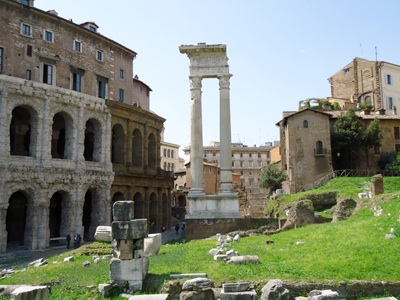
Photo: The Theatre of Marcellus
The Jewish Ghetto is behind this, where one can eat Jewish Roman cuisine in a kosher bar a few doors down from a Hare Krishna centre. I ate a slice of pizza while watching the Simpsons in Italian, which seemed like an appropriate way to end the day’s excursion.
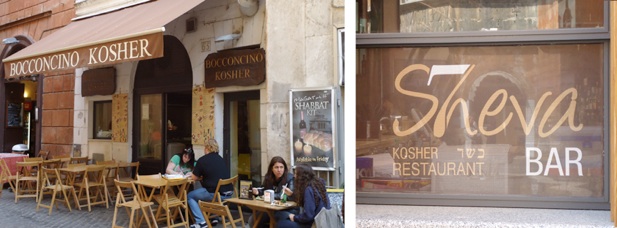
Photo: Jewish sector of Rome.
6 April
Painting day.
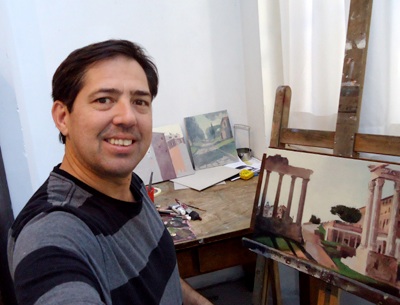
Photo: Painting in the studio.
7 April
Returned to explore the southern end of the forum, looking at warehouses and The House of the Vestal Virgins whose occupants were entrusted to keep the sacred fire burning in Rome. A life-sized marble statue of each Head Vestal originally lined the courtyard that faces onto the forum. The name of one has been erased from the base. Some believe this refers to Claudia who converted to Christianity marking the decline of the pagan era. The Vestals took a vow of chastity and were considered married to the state, which appears to have became the model for Catholic nuns.
Nearby a temple honoured the gods of war and fertility. It seems the Romans responded to correlating opposites (i.e. also considering the oppositional role the temple to Vejovis might have served to The Temple of Jupiter Optimus Maximus.)
The journey up the Via Sacra (Sacred Way) ends with the Arch of Titus, constructed in the first century and celebrating the destruction of Jerusalem. The Arch of Septimius stands diagonally opposite at the north-eastern end of the forum, next to the Umbilicus Urbis Romae and the Milliarium Aureum. One wonders whether a relationship between the two was conceived, ala Janus, with one marking the coming and the other the going.
My paintings have centred on the highway and the high-rise in which the transitory and the monumental are represented. The victory arch combines both in relation to a fleeting event in history.
During the Middle Ages the Arch of Titus was incorporated into a wall. It was in serious disrepair before the structures around it were removed and it was restored in 1817.
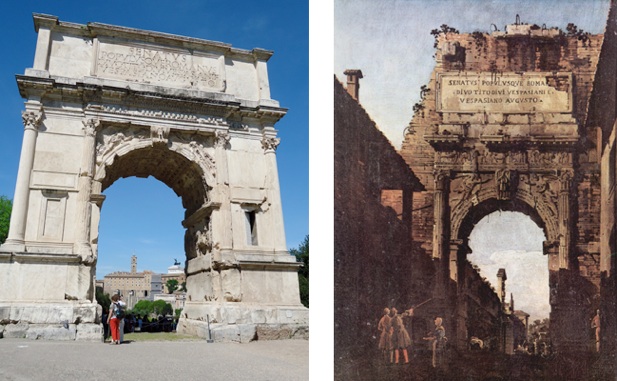
Photo: The Arch of Titus today and as depicted by Canaletto in 1744.
A road from the Arch of Titus also ascends the Palatine where in contrast to the cluttered forum, palaces and ruins are set in cultivated gardens and amongst the wilder Roman Pines, reminding one of paintings by Sydney Long and Rick Amor. This view reminded me of Edward Hopper.
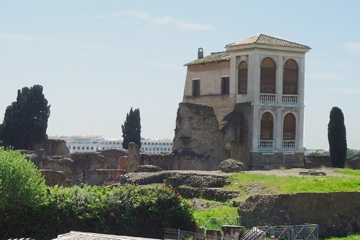
8 April
A couple of studies.
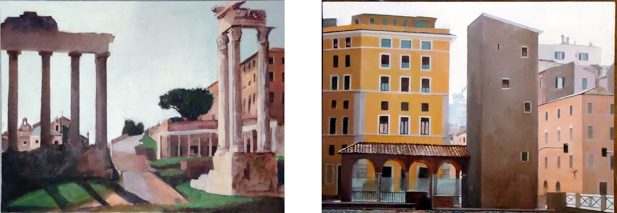
From my sketch book.

9 April, 2011.
I was fortunate to receive reserved tickets to an exhibition at the Palazzo Farnese, (thanks to kind people at the BSR). This late Renaissance palace houses the French Embassy and is not usually open to the public. From the outside it looks quite severe and like it might have been designed upside down. It’s interior, however, is richly and ornately decorated.
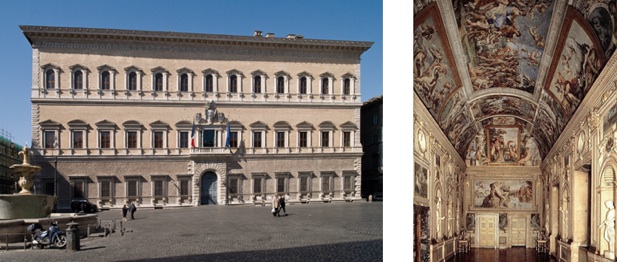
Photo: The Palazzo Farnese and its main gallery decorated by Annibale Carracci.
The exhibition features an imposing antique statue of Hercules that came from the Baths of Caracalla, and a Kallipygian Aphrodite which means literally the “Venus of the beautiful buttocks”.
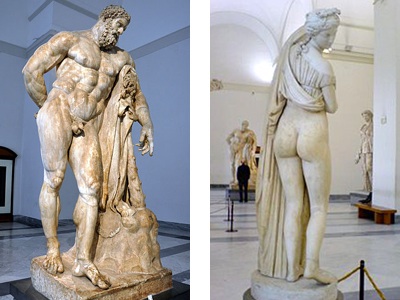
Photo: The Farnese Hercules and Venus of the Beautiful Buttocks.
These masculine and feminine deities were part of the original Farnese collection and set the theme for the frescoes by Annibale Carracci that appear throughout the place. The highlight is the main gallery where mythological scenes are depicted within painted frames and an illusionistic architectural setting. The craftsmanship is made more incredible when you consider that frescoes are made by staining wet plaster before it dries, and like Michelangelo’s famous work in the Sistine Chapel, is painted on the ceiling.
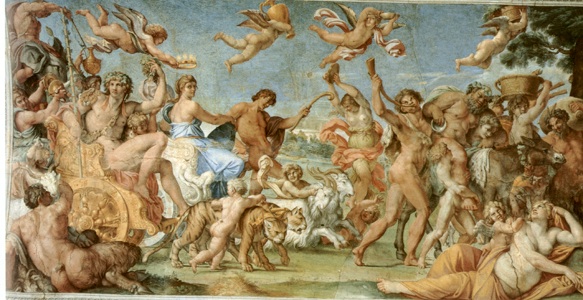
Photo: The main panel from The Love of the Gods, The Triumph of Bacchus and Ariadne.
This ceiling fresco cycle finds a harmony between earthly and celestial love, although Carracci polarises virtue and pleasure in an oil painting of a young Hercules having to choose between the temptation of vice and the difficult path to glory as offered by two women.
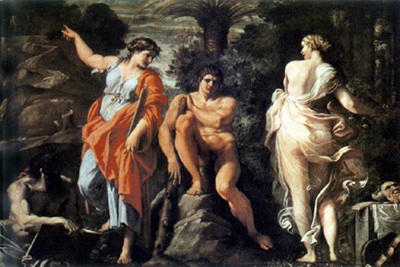
Photo: The Choice of Hercules, Annibale Carracci, 1596. Oil on canvas, 166 x 237 cm.
The hunched form of an old woman begging confronted me as I stepped outside the Farnese Palace.
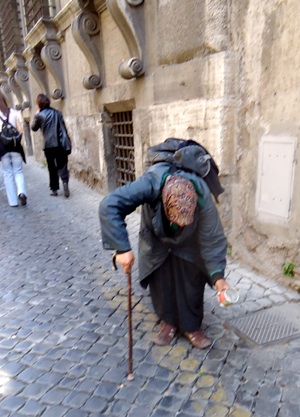
Photo: Poverty and opulence at the Palazzo Farnese.
12 April
Gave a Powerpoint presentation in the lecture theatre, introducing my work and my project, to about 40 people. It was good to get an introduction to the works of the other new arrivals. This includes a diverse range of visual artists covering expressive abstract painting, graphic pastiche, domestic Dada, and even Duchampian air sculptures.
13 April
The Wed evening lecture was based on ancient texts in relation to the topography of Rome. A lot was beyond my limited comprehension but I think sacred groves were identified as occupying the sites where major temples were constructed. The dark forms of the Roman Pines and Cyprus trees certainly contrast with the geometrical lines of the architecture throughout the city. It would be curious if they played a part in the temple’s construction, as a kind of “complimentary opposite” to the more organic structures of nature.
An Australian tour group lead by Dr Christopher Allen and Michelle Hiscock (who are William Fletcher Foundation board members) attended the lecture, and I had the pleasure of showing them my studio and their company for dinner.
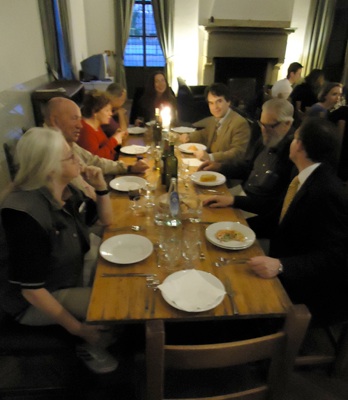
Photo: Dinner guests at the BSR.
